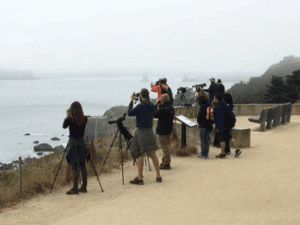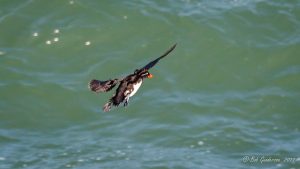Birders thrilled watching wayward bird at Lands End
by Janice Bressler
Editor’s Note: This article originally appeared in the Richmond ReView/Sunset Beacon August 7, 2018
Bird watchers from all over California have been flocking to the Outer Richmond District this summer, hoping to spot a Parakeet Auklet – a little seabird that spends this time of year breeding on the rocky shorelines and islands around Alaska. Why are birders looking in this western district of San Francisco for a bird that should be in Alaska now? Are these people mixed up?
No, this particular bird is.
The Parakeet Auklet being stalked and sighted at Lands End this summer, and much talked about in local birding circles, is what is known as a “vagrant” bird, or “one that has strayed a long way from its expected breeding or migrating range,” according to Bay Area ornithologist John Sterling, who has worked for the Smithsonian Migratory Bird Center in Washington D.C. and now heads an environmental consulting and guide company in the Bay Area.

Sterling said there are different conditions that can explain vagrancy in groups of birds and various theories for why an individual bird might become vagrant. In a non-scientific aside he added, “I have to say that this bird staying here in San Francisco at this time of year is pretty weird.”
One of the vagrant auklet’s favorite places in San Francisco appears to be Hermit Rock, a craggy rectangular boulder that rises just off the shore below the part of the Lands End trail known as Mile Rock Overlook. That is where most of the birders who have posted sightings of the auklet say they have seen the bird.
Sterling recently came to Lands End to try to catch a glimpse of the bird, and not only made a sighting, but managed to take several photographs of the bird in the water. When he first arrived and stationed himself at Mile Rock Overlook, there were already seven or eight other birders there, scanning the rocks and water below.

A Parakeet Auklet has been sighted at Lands End. Courtesy photo.
Ever since a sighting of the bird was first posted this year on July 9, birders have come daily not only from in town, but from cities all over the state. Scores of birders have come long distances, day after day, and waited for hours for a chance to see the auklet.
Serious birders keep lists of the types of birds they have seen in their lifetime, and many birders visiting Lands End this summer hope to add the Parakeet Auklet to their personal list.
Not all of the birders who come to Lands End are lucky enough to actually catch sight of the bird, and others do so only after spending two, three or more days of watching and waiting.
On the other hand, there are lucky birders who catch a sighting on their first day out.
Reef Comber, an avid 23-year-old birder, drove to the City with friends from Santa Cruz and arrived about noon. By 2 p.m., Comer reported with delight that he had spotted the auklet.
“It was in the water, very close to shore, ducking under the waves,” he said.
Although ornithologists may not typically use the term “cute” to describe a bird, the Parakeet Auklet is considered by many people to be a very cute bird.
Roughly half the length of a seagull, it has a round head, small pale eyes and a very thick short orange-red bill that it uses to eat gelatinous jellyfish. Its chest is white, its head and back mostly black, and it has a distinctive white streak behind its eye.
Male and female parakeet auklets look alike, with no gender-specific markings, so no one can say for sure whether the vagrant auklet at Lands End is a male or a female.
Another unknown is exactly why this vagrant Parakeet Auklet is staying here all alone in San Francisco.
“Most species of birds have some form of vagrancy, and groups of birds can become vagrant episodically due to environmental conditions, like extreme weather or parasite loads,” Sterling said.
As for what causes an individual bird to become vagrant, Sterling explained that one widely discussed theory is that there is a kind of cross-wiring or reversal in the bird’s internal GPS system, so that when it migrates, instead of flying north, it flies south.

While most of the birders coming out to Lands End to look for the parakeet auklet are adults, at least one young birder who has not yet graduated from high school came on his own, by bus, from Noe Valley.
Nicholas Forestell, 13, said he has been bird watching and learning about birds since he was 10 and hopes to add the Parakeet Auklet to his “life list.”
According to the websites that are currently posting sightings of the parakeet auklet, 2018 is not the first year that this vagrant Parakeet Auklet has summered in San Francisco. The bird was first sighted around this time of year in 2016, and came back again in July of 2017.
One question birders ask is: Where does this vagrant parakeet auklet go after the summer?
“No one can say for sure, and of course, we can’t ask the bird,” Sterling said. “But, the Parakeet Auklet is a pelagic species – one that spends most of its life on the open sea.”
Although it is not one of the species officially listed as “endangered” under the Endangered Species Act, the Parakeet Auklet is covered by the Migratory Bird Treaty Act, which marks its 100th anniversary this year.
Passed by the U.S. Congress in 1918 to protect birds from indiscriminate destruction, the law is being much discussed among bird advocates in San Francisco and around the country because of proposed changes to the law.
Those changes, according to the National Audubon Society, would weaken the law’s ability to protect birds from being killed “incidentally” by certain industries. As long as the vagrant Parakeet Auklet stays at and around Hermit Rock this summer, the birders are certain to keep coming and waiting and looking.
A man who asked to be identified only as “Larry,” from Napa, admitted that last year he spent many hours at Lands End looking for the Parakeet Auklet without ever seeing the bird. He is already on his fourth trip this year.
“It’s a lot cheaper than buying a ticket to Alaska,” he said.
Janice Bressler is a longtime resident of the far west end of San Francisco, She has just recently been introduced to the delights of birding by her friend, Cyndi Bakir. She is a new member of the Golden Gate Bird Alliance.
